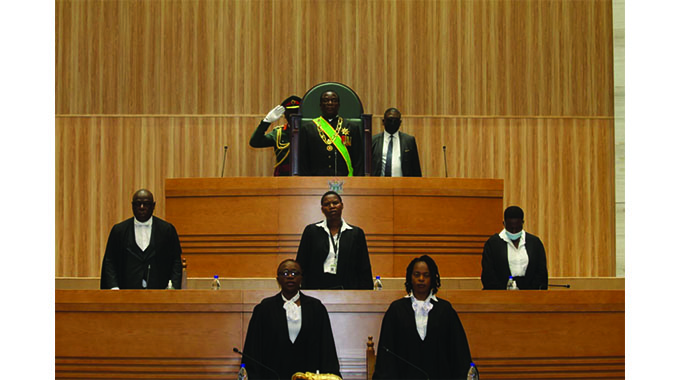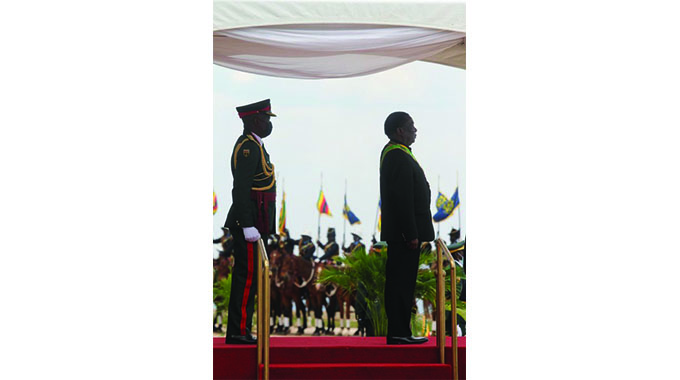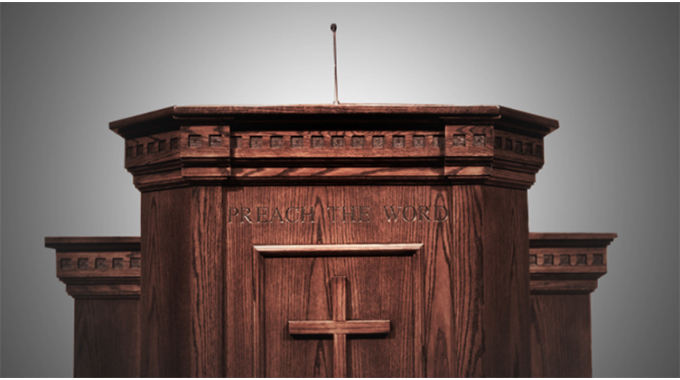History made as President opens 9th Parliament at new complex

Ranga Mataire, Group Political Editor
President Mnangagwa yesterday officially opened the 4th Session of the 9th Parliament of Zimbabwe at the new parliament complex in Mt Hampden, Harare.
While the focus for many was on the President’s State of Nation Address (SONA), very few could escape the significance of the event particularly the fact that this was the first time in post-independence Zimbabwe to have parliament business being conducted away from a colonial building along Nelson Mandela Avenue in Harare’s CBD.
It was a historic moment that confirmed the positive strides being made in engagement and re-engagement as the construction of the building is a product of solid bilateral relations existing between Zimbabwe and China.

Built at a cost of nearly US$200 million, the construction of the imposing structure started in November 2018 and was completed in April 2022. It took 42 months to complete instead of 32-months timeframe due to Covid-19 disruptions.
Covering an area of 33 000 square metres, the six story building houses both the Upper and Lower Houses of the Zimbabwean Parliament. The construction of the building was undertaken by the Shanghai Construction Group through a US$140 million grant by the Chinese government to Zimbabwe.
The spaciousness of the building contrasts sharply with the old colonial building that used to house both Lower and Upper Houses. Sitting on a historical Mount Hampden hill (the original destination of the Rhodesian Pioneer Column, named after English politician John Hampden by the hunter and explorer Frederick Courteney Selous), the six-storey building is a magnificent piece of architecture exhibiting Zimbabwean historical and cultural traits.
Zimbabwe’s first parliamentary building was built in the late 19th century by colonial rulers. The building only had capacity of 100 legislators and had become too small for the 350 legislators and an estimated 248 support staff, as of July 2020. Relocating to a new site in Mt Hampden was first conceived in the early years of our independence in 1983.
The new seat of parliament borrows a lot from the iconic Great Zimbabwe monument upon which Zimbabwe derives its name. The new parliament has a combined floor space of 33 000 square metres, with two main sections – a six-storey office building and a four-storey parliament building. The office building and parliament are connected by three bridges on each floor. The new structure has more space with a capacity of 400 seats with the new Senate Chamber having 150 seats. It has extra facilities of conferencing, 15 committee rooms and adequate space for office staff and parking.
So what does this new parliament complex signify to an ordinary Zimbabwean?
First, it represents an aspirational desire to chart a new course that is reflective of our history and culture as Zimbabweans. This is shown by the overall design of the building, which borrows a lot from the Great Zimbabwe monument particularly the circular shape and the rock designs.
The new parliament building represents an inspirational desire to reconnect with the source – the Great Zimbabwe monument that stands as one of the most extensively developed centres in pre-colonial times. It testifies the organisation, autonomy and economic power of the indigenous people.
According to panticarchitects.com, the architectural design is inspired by our historical heritage and tradition commonly referred to as concentric which encompasses aspects of radial evolution of the design of a traditional village. The central focal point or the meeting place represents the ‘Chamber of the House’. The hierarchical structure of the chambers is illustrated by the upper chamber being a level above the lower house. As with the traditional plan, both chambers are placed where quiet and parliamentary ‘sanctity’ prevail. It is the central core of the village planning concept that the important issues of rural life were are still debated.
Radiating from this core are the corridors of power, containing the committee rooms, ministerial offices, secretariats and other ancillary offices thereby replicating the stratification of village life where social status from the first wife near the centre of the village to ‘huts of the herd boys’ at the outer circumference of the social stratum is located.
The Conical Tower is also reflected in the design and represents a place where important meetings of both houses take place. Lesser conical tower replications emphasise the entrance to the building. The gracious curve of the main entrance to the Great Enclosure at the Great Zimbabwe, together with rising change of level is evoked in the powerful entry statement conceptualised for both houses. The high walls surrounding the traditional village are captured and are suited for the high ground site of the new parliament complex.
Most revered cultural places of Kings were usually located on prominent hilltops for security reasons but also to give a structural status classification. The dominance of the Kopje site in the townscape of Harare clearly expresses this link with traditional planning concepts. To reach atop, one has to go through a circular procession just like at Great Zimbabwe, which gives the aspect of processional and ceremonial aspects.

Second, the new parliament complex represents the pragmatism of President Mnangagwa’s desire to prioritise infrastructure development particularly institutions that enhance the deepening of democracy. History will record that it was during his time as President that the new parliament was built, completed and occupied.
Third, the new parliament proves beyond doubt that the engagement and re-engagement drive is bearing fruits. It is one of the most important projects in China-Africa cooperation aimed at strengthening friendship and solidarity between the people of Zimbabwe and China while improving facilities for better service to Zimbabwean people. There will be no loan repayment to Zimbabwe as the parliament is a gift to Zimbabwe.
Fourth, the new spacious parliament allows democracy to deepen and flourish. Parliament is a critical institution of governance made up of all representatives from different political parties.
It guides and controls government through the enactment of laws and people’s aspirations find expression in their parliamentary representatives. The project therefore supports democracy in Zimbabwe while boosting the country’s image.
The Parliament of Zimbabwe is a bicameral legislature composed of the Senate and National Assembly. The Senate is the upper house consisting of 80 members, 60 of whom are elected by proportional representation from ten six-member constituencies corresponding to the country’s provinces.
Bicameral simply means “two rooms” implying a parliament made up of two separate houses or chambers. The two houses are the Legislative Assembly or Legislative Council made up of lower and upper houses.
The Zimbabwe constitution provides for the election of 350 Members of Parliament consisting of the Senate and National Assembly and each has 80 and 270 members respectively.
Members of Parliament perform legislative, representative and oversight functions.
They are elected for a 5-year term which runs from the date on which the President-elect is sworn in and assumes office. Parliament stands dissolved at midnight on the day before the first polling day in the next harmonised election.











Comments